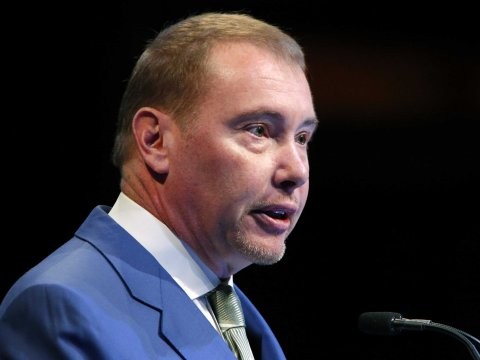Municipal Bonds Back to Basics in 2014 Business Insider
Post on: 23 Июль, 2015 No Comment

Municipal bonds faced some ups and downs in 2013, falling victim to Fed taper speculation and negative press that dogged Detroit and Puerto Rico and understandably scared off some investors. Sheila Amoroso and Rafael Costas, co-directors of our Municipal Bond Department, note that while there are still some issues to work through and even despite the sometimes-shocking headlines, not all news in the world of munis is bad news. They say investors need to get back to the basics and re-examine the reasons for investing in municipal bonds.
Rafael Costas
Sheila Amoroso and Rafael Costas
Co-Directors, Municipal Bond Department
Franklin Templeton Fixed Income Group®
The 2013 municipal bond market could be referred to as “Dr. Jekyll and Mr. Hyde.” The year opened with the market’s broadly positive momentum from 2012’s price appreciation and strong positive flows into municipal bond mutual funds. However, once the Federal Reserve began to openly discuss the possibility of tapering its bond-buying program, fixed income markets—and the retail-driven municipal market in particular—entered a period of uneven performance that lasted for the remainder of 2013. The negative tenor of the municipal bond market was exacerbated by the city of Detroit’s bankruptcy filing in July and by significant price erosion in Puerto Rico bonds, resulting from negative press and media coverage about the Commonwealth’s fiscal and economic situation. Consequently, municipal bond funds had strong net outflows during 2013.
Sheila Amoroso
While issuers like Detroit and Puerto Rico dominated the headlines with their troubles, state and local tax increases along with US economic growth have generally helped state and local revenues to increase. While there are cost pressures building up over time, such as pension obligations and other retirement benefits, states and localities have generally seen their fiscal positions improve. Although we are encouraged by this news, we still caution that such progress is likely to be slow and the ability of states and municipalities to meet their challenges may be uneven across the nation, with some bond issuers being more proactive than others in addressing expenditures.
The municipal bond market started 2013 with yields generally at or near 50-year lows, and we felt the potential for continued price appreciation was very minimal. We suggested that investors focus instead on what we believe is the primary purpose of investing in municipal bonds: the potential for tax-free income.1 While market corrections and periods of weak performance are painful from a price perspective, we believe funds able to begin investing money at higher interest rates may be able to improve the income potential of their investments, which could lead to increased dividends.
Lower supply and improving credit fundamentals were generally supportive of municipal bond values in 2013. However, levels of demand were volatile over the period, and we believe this volatility is likely to continue through 2014. While municipal bond funds have continued to experience negative flows, the magnitude of these flows has decreased markedly since late summer 2013. In our view, the generally higher yields available on municipal bonds at year-end may entice more investors who have been sitting on the sidelines waiting for higher yield potential. Additionally, more and more baby boomers are retiring and seeking income for their retirement years, and higher federal taxes (and in some cases, state taxes) can make the tax exemption of municipal bonds more appealing. Conversely, negative news of any credit event might dampen demand (as Detroit and Puerto Rico did), and a continued rally in the equity markets may syphon funds away from fixed income. It is impossible to tell what forces will prevail, but we believe that the municipal bond market can provide attractive tax-free income potential for those who seek it.
Related Posts:
Get more perspectives from Franklin Templeton Investments delivered to your inbox. Subscribe to the Beyond Bulls & Bears blog.
For timely investing tidbits, follow us on Twitter @FTI_US and on LinkedIn .
All investments involve risks, including possible loss of principal. Municipal bonds are affected by interest rate movements. Municipal bond prices, and thus, a tax-free income fund’s share price, generally move in the opposite direction of interest rates. As the prices of the municipal bonds in a fund portfolio adjust to a rise in interest rates, the fund’s share price may decline. Changes in the credit rating of a bond, or in the credit rating or financial strength of a bond’s issuer, insurer or guarantor, may affect the bond’s value. To the extent a municipal bond fund has investments in particular states or US territories, such as Puerto Rico, adverse economic and regulatory changes in such states or territories may cause the fund’s share price to decline. These events may include economic or political policy changes, tax base erosion, constitutional limits on tax increases, budget deficits and other financial difficulties, and changes in the credit ratings assigned to the territory. For more detailed information about risk, please review a current Franklin tax-free income fund prospectus.
1. For municipal bond fund investors subject to the alternative minimum tax, dividends may be taxable. Distributions of capital gains are generally taxable.
Beyond Bulls & Bears — Perspective from Franklin Templeton Investments (U.S.) — At Beyond Bulls & Bears, our mission is not to bring you the latest hot stock tip or bit of Wall Street gossip. It’s to share the on-the-ground, long-term perspectives of investment professionals adept at navigating the increasingly complex world of global investing. Markets change. The fundamentals of good investing don’t.














